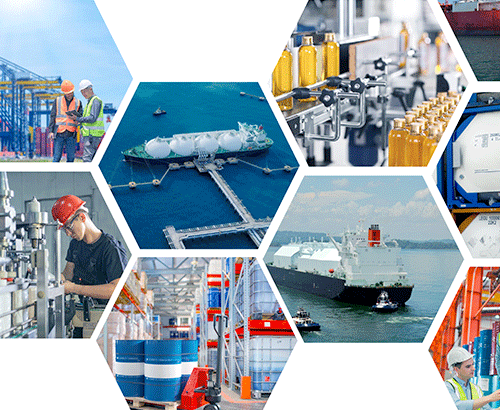The Path to Environmental, Social and Governance Goals Runs Through the Built Environment

There’s no one solution to the environmental and social challenges that we face, but many in the built environment across the infrastructure value chain are looking for ways to improve their environmental, social and governance (ESG) impact.
While firms across the industry have been steadily driving ESG goals forward for a long time, now they are getting an increased focus through a
broader lens.
Whether approaching ESG from the perspective of a company operator or an investor, the participants that make up the built environment offer a major contribution to the overall ESG equation. As engineering and construction (E&C) make up more than 11% of global gross domestic product (GDP), E&C firms play a fundamental role in how ESG investments and operations are prioritized.
Focusing on the investing side of the equation, ESG has been greatly influencing the environment for mergers and acquisitions (M&A) over the past 18 months. This impact has been seen across all of FMI Capital Advisors’ subsectors in different ways, but common themes have emerged across the sectors FMI serves.
Increased Interest in ESG Appears to Be a Baseline Requirement
Certain sectors tied to cyclical industries such as construction have often been overlooked by private capital and larger strategic investors. But with the collective rotation across energy, infrastructure and the required value chain needed to service those megamarkets, increased interest has arisen.
Many strategic buyers and financial parties who are searching for opportunities and access to ESG-related investments (specifically the environmental and climate components) have previously overlooked certain segments of engineering, construction and the built environment in general.
Now with investors’ goals being viewed and ultimately measured through the thematic lens of ESG investment, and the need to find ways to deploy capital to meet that requirement, the interest level in the industry has risen significantly with existing participants and broadened further with new entrants.
Game of Spoons
There are certain segments of the market where the COVID-19 pandemic, the focus on ESG and the recent infrastructure bill have led to an all-out grab for providers experienced in these segments.
Examples include:
- The demand for renewables and energy efficiency services.
- The need for specialized engineering and construction providers to help build out supply chains.
- Demand for utility contractors to support deferred maintenance needs as well as an expanding focus on power resiliency.
- Aggregate producers in certain geographies to address the replacement and repair of roads and highways with a greater focus on sustainable materials.
This race to lock up access, exposure and talent serving select segments started as a sprint, but has turned into a high-speed marathon as opportunities continue to become available and demand vastly outstrips supply.
The K Valuation
Valuations for companies across the board are at all-time highs, driven by increased interest, competition, growth profiles and the abundance of capital. Peeling back the onion across the sector landscape reveals that this increase in valuations is not evenly distributed.
Well-run companies with exposure to more attractive segments, defensible positions and reoccurring revenue models have seen greater increases in market valuations than the industry as a whole. This valuation divergence follows the K-shaped recovery that is discussed across the economy, where some industries recover quickly while others suffer a prolonged downturn.
Even within subsegments, the market’s perception of value can diverge massively on seemingly similar assets. While this has always been inherent in valuations, the last 18 months have amplified this trend.
This all goes to show that investors are increasingly putting their money into investments with ESG exposure as well as the operational execution of those investments on ESG criteria. This approach appears to be accelerating across the built environment, as witnessed across all of FMI Capital Advisors’ market sectors during the past several months. Here is a brief overview:
Construction Materials
Environmental improvement is a significant focus in the construction materials space. The National Ready Mixed Concrete Association (NRMCA) put this topic front and center at its national conference in 2021. Looking across the subsegments of this vertical, there are two common focus areas:
- Carbon footprints: Ready-mix producers have spent a lot of time trying to reduce their carbon footprint.
- Recycled products: Hot-mix asphalt has focused on introducing recycled asphalt products into the mixes, allowing for big cost savings and creatinga more environmentally friendly footprint. Aggregate producers as well are putting a lot of emphasis on recycled materials (crushed concrete, etc.).
Specialty Chemicals
Specialty chemicals are critical catalysts in the built environment’s push toward better performance and lower environmental impact. Examples include:
- Spray foam insulation and sealants are key components for energy efficiency.
- Solar reflective coatings can keep buildings cooler and reduce energy bills in addition to extending the life of the roof.
- Air and water treatment require significant chemical components and can improve the environmental and health aspects of society.
- Specialty chemicals can help drive the efficiency of recycling processes and support future use cases for discarded materials.
Advances in chemistry are at the core of improved materials and the ESG movement, and, consequently, specialty chemicals enabling such improvements are getting a lot of attention.
Building Products
As with construction materials, sustainable building products are a cornerstone of any long-term macro environmental objective. FMI has seen building products transactions driven by the growing demand for components in the renewable energy supply chain.
Architecture, Engineering & Environmental
So much of the ESG story starts in design, engineering and the idea of viewing a holistic ecosystem. This often front-end work determines the viability and success of projects over the entire life cycle, leading to an increase in the emphasis put on this sector. Many of today’s young professionals across architecture, engineering and environmental fields all have ESG top of mind, allowing forward-looking firms to compete for the talent needed to meet today’s needs.
Contractors & Construction Services
The construction industry has received significant bad press in recent years for its lack of innovation relative to other industries. While that may be a true statement for many firms because of dispersed job sites, disaggregated subcontractors and inefficient internal communication channels, contractors and construction services firms are in many ways the boots on the ground leading today’s sustainability push.
Energy Solutions & Cleantech
ESG initiatives are an inherent part of the energy solutions and cleantech space that often overarches various subsectors of the built environment. The pillars of decentralization, decarbonization and digitization serve as both growth drivers and key investment mandates.
FMI has advised on more than a dozen energy service company (ESCO) transactions since 2018, all with ESG themes as key drivers of these transactions. The convergence and cross-pollination of the supply side and the demand side of the energy equations are increasingly common.
Utility & Communications Infrastructure
Major utilities across the U.S. are intently focused on increasing their renewable power generation. Duke Energy, the nation’s largest power provider, has set a goal of reducing carbon emissions by at least 50% by 2030; 7% of its current electrical output comes from wind, solar and hydroelectric plants, and this is projected to grow to 23% by 2030. This requires a major and continuous build and supporting service to achieve. FMI has seen this transition as a key deal driver, further accelerating deferred maintenance needs.
Energy & Industrial Services
The energy transition theme has proven to be disruptive to certain segments of the traditional energy industry as well as industrial markets, which have been impacted by both the volatility in the oil and gas space as well as the emphasis on ESG demands imposed by various stakeholders. Companies in the energy and industrial services space that are flexible and can successfully adopt innovative approaches have proven to be valuable.
While oil and gas and sustainability may not always be discussed in the same sentence, the sector is responsible for trillions in revenues each year. So innovation and an emphasis on ESG themes will be key for continued success in the space.
Looking Ahead
Companies looking to capitalize on their positions in the industry via a sale should consider how they are uniquely situated in relation to ESG and how those competitive advantages will strategically benefit potential acquirers. Whether it is the segment they serve, the services they offer, or the way they execute their work, many firms across the industry have strong practices that are resoundingly pushing ESG goals forward.
Investors or acquirers looking for defensible angles that contribute to the improvement of ESG goals at local, national and global levels can find unique opportunities with strong ESG qualities that exist across the built environment.
The built environment―and the companies, people and stakeholders that serve it―offers an exciting ecosystem to explore through an ESG lens. The growing influence of ESG across sectors provides commonality and fortitude to ideas that have historically been seen as fringe, but have been inherent to the built environment for a long time.
This reorientation of market pressures offers both challenges to meet and vast opportunities to pursue. FMI Capital Advisors is excited to continue to help clients across the built environment navigate the M&A market today, tomorrow and well into the future.



